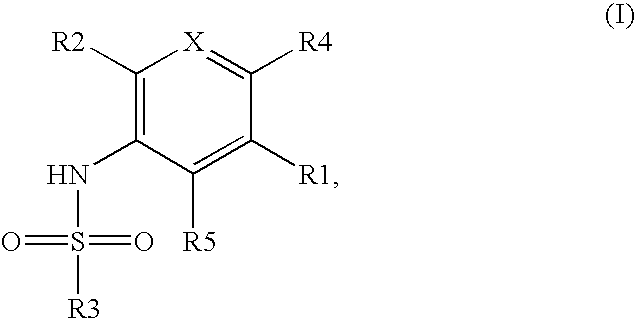Pyridosulfonamide derivatives as p13 kinase inhibitors
a technology of pyridosulfonamide and kinase inhibitor, which is applied in the field of pyridosulfonamide derivatives, can solve the problem of limited expression of the enzym
- Summary
- Abstract
- Description
- Claims
- Application Information
AI Technical Summary
Benefits of technology
Problems solved by technology
Method used
Image
Examples
example 1
N-(2-chloro-5-phenyl-3-pyridinyl)benzenesulfonamide
[0322]
a) N-(5-bromo-2-chloro-3-pyridinyl)benzenesulfonamide
[0323]To a stirred solution of 3-amino-5-bromo-2-chloropyridine (5.0 g, 24 mMol) in CH2Cl2 (50 mL) was added pyridine (5.0 mL, 61.8 mMol) followed by benzenesulfonyl chloride (6 mL, 47 mMol) drop wise over 5 minutes. The reaction was stirred at RT for 3 days and evaporated to dryness under vacuum. (LCMS showed only 1% starting material remained, 55% desired product and 44% di-sulfonylated product.) The residue which remained was taken up in MeOH (50 mL) and treated with K2CO3 (10 g, 72.3 mMol) and H2O (1 mL). The suspension was stirred and refluxed (80° C. oil bath) for 1 h. (LCMS showed complete conversion of the di-sulfonylated product to the title compound.) The reaction was evaporated to near dryness and poured into a solution of NH4Cl (25 g) in H2O (200 mL). The suspension was stirred for 30 minutes (resultant pH ˜7-8), filtered through a fine sintered glass funnel, was...
example 28
N-[5-(2-amino-5-pyrimidinyl)-2-chloro-3-pyridinyl]benzenesulfonamide
[0326]
a) N-[2-chloro-5-(4,4,5,5-tetramethyl-1,3,2-dioxaborolan-2-yl)-3-pyridinyl]benzenesulfonamide
[0327]To a 100 mL round-bottomed flask was added N-(5-bromo-2-chloro-3-pyridinyl)benzenesulfonamide (4.1 g, 11.79 mmol), pinacoladodiborane (3.59 g, 14.15 mmol), and potassium acetate (3.47 g, 35.4 mmol) in N,N-dimethylformamide (DMF) (50 ml). The reaction mixture was degassed by nitrogen, and PdCl2(dppf)-CH2Cl2 adduct (0.482 g, 0.590 mmol) was added. The reaction mixture was heated to 90° C. overnight. N,N-Dimethylformamide was evaporated, black oil dissolved in DCM, 2 g of decolorizing carbon was added. The reaction mixture was stirred for 10 min, and then filtered through short pad of silica. Black oil was evaporated, and the residue was purified via Analogix (hexane:ethyl acetate 30 to 70%). Only colorless fraction with product has been collected (not the yellow one) and evaporated. Solid was suspended in hexane an...
example 45
N-{2-chloro-5-[3-(5-methyl-1,2,4-oxadiazol-3-yl)imidazo[1,2-a]pyridin-6-yl]-3-pyridinyl}benzene sulfonamide
[0330]
a) N′-(5-bromo-2-pyridinyl)-N,N-dimethylimidoformamide
[0331]To a solution of 2-amino-5-bromopyridine (5.0 g, 28.9 mmol), in dry MeOH was added DMF-DMA (12.7 mL, 95.4 mmol) in a sealable reaction tube. The reaction was purged with nitrogen, sealed and heated to 70° C. After 5.5 h, the reaction mixture was cooled to room temperature and concentrated under reduced pressure. The resulting solid was recrystallized from hexanes to give 4.1 g (62%) of N′-(5-bromo-2-pyridinyl)-N,N-dimethylimidoformamide as a yellow solid. MS(ES)+ m / e 228 [M+H]+.
b) 6-bromoimidazo[1,2-a]pyridine-3-carbonitrile
[0332]To a mixture of N′-(5-bromo-2-pyridinyl)-N,N-dimethylimidoformamide (3.8 g, 16.7 mmol) in i-PrOH (80 mL) was added bromoacetonitrile (2.3 mL, 33.4 mmol) followed by NaHCO3 (3.5 g, 41.8 mmol) in a sealable reaction tube. The reaction was purged with nitrogen, sealed and heated to 100° C. ...
PUM
| Property | Measurement | Unit |
|---|---|---|
| Composition | aaaaa | aaaaa |
| Cell angle | aaaaa | aaaaa |
Abstract
Description
Claims
Application Information
 Login to View More
Login to View More - R&D
- Intellectual Property
- Life Sciences
- Materials
- Tech Scout
- Unparalleled Data Quality
- Higher Quality Content
- 60% Fewer Hallucinations
Browse by: Latest US Patents, China's latest patents, Technical Efficacy Thesaurus, Application Domain, Technology Topic, Popular Technical Reports.
© 2025 PatSnap. All rights reserved.Legal|Privacy policy|Modern Slavery Act Transparency Statement|Sitemap|About US| Contact US: help@patsnap.com



